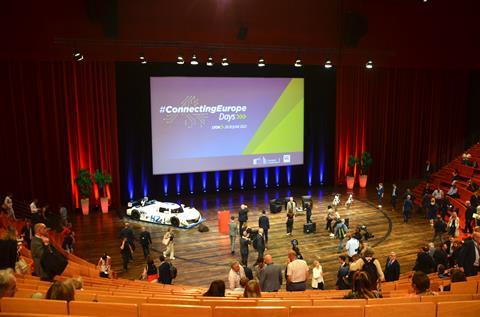
FRANCE: The EU’s flagship annual transport summit took place in Lyon on June 28-30, during the final days of the French presidency of the Council of the European Union.
Formerly known as the TEN-T Days, the Connecting Europe Days event brought together politicians, industry representatives and the European Commission to discuss the development of transport across the member states, and its role in helping them achieve the sustainability targets set out in the EU Green Deal and the Sustainable and Smart Mobility Strategy.
Alongside the main discussions, a series of exhibits and demonstrations covered major EU-funded infrastructure projects, as well as presenting advances in vehicle design and autonomous transport technology. In addition to sustainable mobility, the importance of transport infrastructure in a military and geopolitical context was a key topic throughout the summit.

The mobility of military forces and equipment was one of the subjects discussed at the Connecting Europe Days. And at all of the conference sessions there was an emphasis on the importance of resilient infrastructure for smart and sustainable mobility.
Infrastructure funds allocated
An announcement on June 29, confirmed that 135 transport infrastructure projects had been selected as eligible for EU co-funding grants totalling €5·4bn, under the latest Connecting Europe Facility call for proposals. These were drawn from a total of 399 applications submitted by the deadline of January 19 2022.
According to the EU, the CEF funding will support post-pandemic economic recovery in all 27 member states by contributing to the construction of missing transport links across the continent, supporting sustainable transport, improving safety and interoperability, and creating jobs. All of the schemes selected for grant funding are located on the TEN-T network.
The European Commission reiterated its objective of completing the TEN-T core network by 2030 and the comprehensive network by 2050, while also ensuring that this infrastructure helps the EU to deliver its climate objectives under the Green Deal. ‘These challenging times have reinforced the importance of our EU transport sector and of having a seamless, well-connected infrastructure network’, explained Commissioner for Transport Adina-Ioana Vălean. In particular, she singled out the funding for refurbishment of the rail-road transhipment terminal at Haniska pri Košicich in southern Slovakia, which ‘will further facilitate our links with Ukraine’.
While the funding will be spread across multiple transport modes, many of the key allocations went to cross-border rail projects, including the Fehmarn Belt tunnel connecting Denmark and Germany and Rail Baltica, which would link Poland, Lithuania, Estonia and Latvia.
Cross-border connectivity
Several agreements were signed during the event to enhance transport connectivity between the EU, Ukraine and Moldova. These included a memorandum of understanding to develop rail links, starting with a commitment to reopen the 23 km cross-border route between Berezyne (Ukraine) and Basarabeasca (Moldova), which has been out of use for 25 years.
The European Commission used the Connecting Europe Days to call for proposals to pilot cross-border rail services, as announced last year in its Action Plan to boost long-distance passenger trains. ‘We need more cross-border rail connections, they must be faster and more affordable’, said Vălean. ‘Today, cross-border rail still faces obstacles to the operation and introduction of new services. These pilot projects are part of our strategy to break down these remaining barriers, and I hope that the industry will get on board without delay.’ The results of the evaluation will be made public by January 2023.
Supporting documents
Click link to download and view these filesCEF Transport calls for proposals 2021: selected projects June 2022
PDF, Size 0.71 mb

















